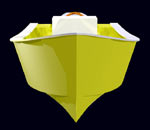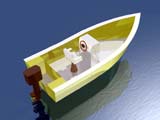|
Redondo Skiff
design by Chris Ostlind
Over the past couple of years, as I’ve been drawn into the world of boat design, I’ve made a concentrated effort to confine my work to sail and human powered vessels. I’ve been a mulithull sailor and canoe/kayaker for a long time and have found most of my experiences in that part of the boating world. My design portfolio reflects that background.

Recently, after successive readings of the exploits of many different guys and their construction of the nearly legendary Tolman Alaska Skiff, I was pulled into the potential of designing a multi-purpose power boat. It wasn’t just the Tolman form that enticed me so much. It was the complete enthusiasm for the design and the potential that the design represented to them in the pursuit of their boating dreams, that got me all caught-up with the fever.
Like a moth circling a back porch light, I searched the web and found dozens of references to the classic skiff form that were available as finished boats as well as plan sets for homebuilders. Gosh, there were ultra deep vees, asymmetrical catamarans, mislabeled party barges, pseudo Bass boats, flat bottom ski boats posing as off-shore hulls…Wow!, the parade of hulls being offered as suitable for near offshore conditions was bewildering.
 (click thumbnails to enlarge)
(click thumbnails to enlarge) |
After reading reviews and reports from experienced designers as well as fishermen who used the hulls to make a living, I settled in on the same form that is used by the Tolman as well as several other successful designs for the application.
There were far more examples in the over 18’ range. That makes a lot of sense, as the boat is typically used for off-shore fishing and pleasure boating and smaller power boats don’t do especially well in the bigger conditions typically encountered, nor is it advisable to have a small boat out in conditions of that sort. Virtually all of these boats have strong vee sections forward with the angled deadrise easing off and being carried all the way aft in varying degrees.
 Most of the boats settle into a deadrise formula that finds something in the neighborhood of 14 degrees amidships and around 8 degrees at the transom. Longer boats, with their heavier weights are deeper in the water with stronger angles to reflect their displacement needs. Most of the boats settle into a deadrise formula that finds something in the neighborhood of 14 degrees amidships and around 8 degrees at the transom. Longer boats, with their heavier weights are deeper in the water with stronger angles to reflect their displacement needs.
I decided to put some time on my sketch pad and the computer to pull together some of my own thoughts as to a suitable skiff for near, off-shore and lake boating.
The boat had to be manageable for a single user, easily trailered and launched and be suited for smaller water conditions as one would find close to shore and in semi-protected bays and lakes. I didn’t have the burning need to develop a full tilt, enclosed wheelhouse or fully constructed forward cuddy. I felt those design concepts were better handled by the boats that were in the 20-26’ range with their superior load carrying ability and size proportions.
I was more after a boat that could be used completely open when the weather was nice and could have a soft, fold-up cuddy cover for drizzly conditions or sleeping aboard. In short, I wanted the top down convenience of a nicely performing, convertible Grand Touring sports boat. One that handled really well and could get up and fly when asked.

Since very few designs were available in the 16’ length, I settled on that size as the perfect fit for my design criteria. She is 6’ 8” on the beam. The Redondo Skiff is a boat that is simple to build, fast on the water with her 30-50 hp outboard and can handle chop with its pronounced vee sections up front that are carried back to an 8 degree deadrise at the transom.
I really liked the incorporated spray rail chine that is seen on several designs of this type for a lot of reasons, so I incorporated a nice rail into the Redondo that starts at the stem and sweeps back to the transom as it echoes the shear. This rail does a couple of things for the design. It deflects wave action and generated spray away from the boat, giving it a drier ride, it really does a job helping to dampen roll when at anchor and it provides a boost to getting the hull up on plane when powered up on long rides.
 The penalties (there always seems to be some kind of penalty for every design decision) are that there is an extra piece to each side of the hull during the build and there is extra wetted surface drag when tooling around in displacement mode. I decided to take those hits and design-in the extra chine for all the added benefits they provide. The penalties (there always seems to be some kind of penalty for every design decision) are that there is an extra piece to each side of the hull during the build and there is extra wetted surface drag when tooling around in displacement mode. I decided to take those hits and design-in the extra chine for all the added benefits they provide.
The boat can be built with a standard steering position to the side of the cockpit or with a centrally mounted steering position if the boat is going to be used more for fishing. The central position allows fishermen to freely move about the hull perimeter while they have a fish on the line without having to climb over the wheel and seat.
Actually, this whole, fishing around the hull, thing kind of busts me up in a way. I fully understand the methodology for the free access, but I have never seen an actual fishing boat of this size that would allow you to move freely around the boat. I mean, what with all the tackle boxes, beer coolers and semi-dozing, grumpy teenagers who are typically on-board for a day fishing trip, it’s just not going to happen the way it is designed.
 No matter, just go by yourself. No matter, just go by yourself.
The first boat is going to be built by a great guy out in Southern California who is a math teacher by day and a free diver and waterman on the weekends. As an avid surfer and board shaper, he has had plenty of experience handling resins and fiberglass, even if this is his first real boat. So, the build process will be very straight-forward for him.
He has two small kids, in addition to his wife, and he wants to have the versatility that this design provides. Even though he is initially building the boat as an open craft, he can always construct a slightly raised profile, foredeck to allow his kids a place to crash should they hit the wall while out on the water, without messing with the overall plan of the design.
Anyway, this is a nice boat for fishing as well as just tooling around and enjoying the water on a nice day.
|

